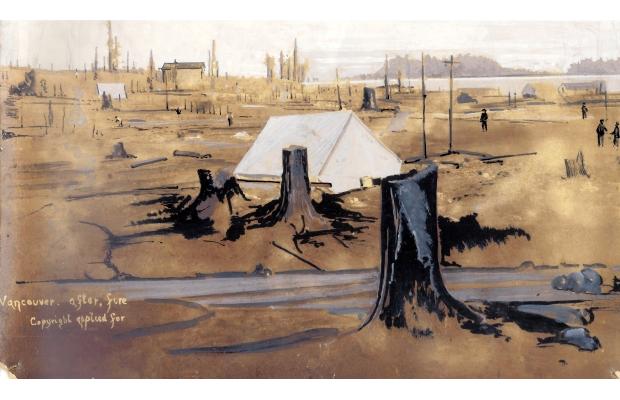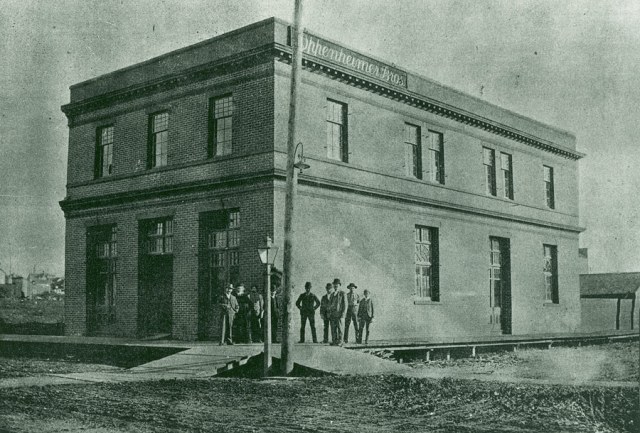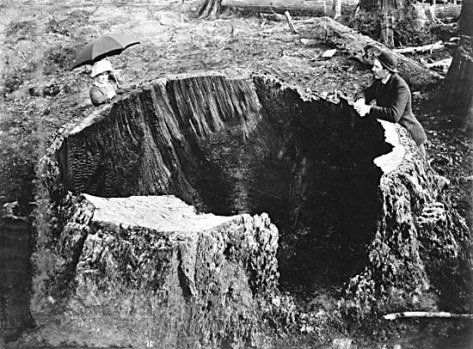

 This is one of the earliest photos of Gastown, taken in 1886 in Maple Tree Square in the town of Granville (now called Vancouver). Locals called it Gastown because the first saloon was started by Jack Deighton, known as “Gassy Jack” because he loved to talk — apparently for hours. The story goes that he rowed up with $6 in his pocket and a barrel of whisky. He told the locals that they could have all they could drink if they helped him build a hotel — the Globe Saloon opened 24 hours later on the corner of Water Street and Carrall. The photo above was taken in front of the hotel, looking across the street to the corner of Carrall and Powell. The store on the corner — Jas Hartney’s Dry Goods & Groceries — now is the location of my store, Angel Vancouver. The maple tree in the photo is roughly the location today of the statue commemorating Gassy Jack. The sign on the tree is a notice about Vancouver’s first election, held on May 3, 1886.
This is one of the earliest photos of Gastown, taken in 1886 in Maple Tree Square in the town of Granville (now called Vancouver). Locals called it Gastown because the first saloon was started by Jack Deighton, known as “Gassy Jack” because he loved to talk — apparently for hours. The story goes that he rowed up with $6 in his pocket and a barrel of whisky. He told the locals that they could have all they could drink if they helped him build a hotel — the Globe Saloon opened 24 hours later on the corner of Water Street and Carrall. The photo above was taken in front of the hotel, looking across the street to the corner of Carrall and Powell. The store on the corner — Jas Hartney’s Dry Goods & Groceries — now is the location of my store, Angel Vancouver. The maple tree in the photo is roughly the location today of the statue commemorating Gassy Jack. The sign on the tree is a notice about Vancouver’s first election, held on May 3, 1886.
Vancouver was incorporated a month earlier, on April 6, 1886, when there were only about 600 residents. Most were men who lived in a small village that comprised a few hotels and bars. The 1884 photo below shows what Water Street originally was — located right on Burrard Inlet, with the dense forest and swamps behind. The annotations on the photo, denoting the owner of each wood-frame building, were written by Vancouver’s first archivist, Major James Matthews. (Click on photo to enlarge the printing.)
(Click on photo to enlarge the printing.)
 All access to to the Vancouver townsite then was by boat. Some stores on Water Street had trap doors in the floor to allow supplies to be loaded onto boats tied up underneath. Below is another early photo of the town. Taken from what is now Main and Cordova (then called Oppenheimer), where the Vancouver Police station now is located. You can see how few buildings there were in 1886.
All access to to the Vancouver townsite then was by boat. Some stores on Water Street had trap doors in the floor to allow supplies to be loaded onto boats tied up underneath. Below is another early photo of the town. Taken from what is now Main and Cordova (then called Oppenheimer), where the Vancouver Police station now is located. You can see how few buildings there were in 1886.
Only two months after Vancouver’s birth, the town burned to the ground in what is known as the Great Fire, which began while workers were falling trees and burning brush. The fire spread so quickly down Hastings Street that people had to jump off the wooden sidewalks to escape the flames, which were spreading faster than a person could run.
All but two of Vancouver’s 400 buildings were reduced to ashes in the blaze. One that survived the inferno was the Hastings Mills, founded in 1863 and the main employer at the time, located at the foot of Dunlevy. Reportedly, up to 28 people were killed. Many more would have died but the Indians on the North Shore paddled over and rescued people who dove into the water of Burrard Inlet, at the foot of Carrall, to escape the flames & intense heat that consumed the small town.

Looking toward Gastown after the Great Fire of 1886, when Vancouver was only two months old. This black-and-white photo, with colour handpainting added later, was taken from roughly where the old Vancouver police station at 312 Main is now.
But the city quickly rebuilt — new commercial structures had to be built of brick to withstand another fire. The two oldest commercial buildings in Vancouver built after the fire of 1886 are the Ferguson Block at No. 2 Powell Street (where Angel Vancouver now is located on the corner of Carrall Street) and the Byrne Building, located across the street at Water and Carrall, the site of Gassy Jack’s original saloon. Another of the oldest brick buildings is a block away, at Powell and Columbia; the warehouse was built in 1887 for the Oppenheimer brothers’ food wholesaling business. Today it is the Warehouse recording studio of Vancouver rock star/photographer Bryan Adams.



 The first Canadian Pacific Railway train pulled into Vancouver on May 23, 1887, with the terminus at a wharf built at the foot of Granville Street. The first big station opened in 1898, with the current station built in 1914 (now the Waterfront Station for SkyTrain, the Canada Line and SeaBus). By then the old tidal flats had been filled in for the railway terminus.
The first Canadian Pacific Railway train pulled into Vancouver on May 23, 1887, with the terminus at a wharf built at the foot of Granville Street. The first big station opened in 1898, with the current station built in 1914 (now the Waterfront Station for SkyTrain, the Canada Line and SeaBus). By then the old tidal flats had been filled in for the railway terminus.
The heart of the city quickly began moving westward from Carrall and Cordova up Hastings and toward Pender. The CPR railway owned land further west, so encouraged development westward to boost land prices. The first Woodward’s store was initially at Hastings and Main (then called Westminster) but the store’s founder, Charles Woodward, expanded to Abbott and Hastings in 1902, when he incorporated Woodward Department Stores. The four-storey department store offered groceries, blankets, furniture and clothing for entire families (it expanded a further seven times until 1926, when the store had a whopping 645,000 square feet).
The downtown movement westward also was prompted by the Hudson’s Bay Company, initially a fur trading company in B.C., building a large store at Granville Street and Georgia in 1883, later expanding in 1890.
Across the street, the first Hotel Vancouver was built in 1888. The area saw logging of trees up to 300 feet tall at the time: Logging was one of  the city’s first industries, helping to supply a population boom that saw houses being built in the West End, the city’s first exclusive neighbourhood for the rich. Before then, the area was sparsley populated until the electric trolley streetcars arrived in Vancouver a year later, in 1889, and ran from the Carrall Street “barns” down Hastings, Granville Street and to Stanley Park, which officially opened in 1888. The streetcars were originally powered by electricity produced by a steam plant at Union Street and Main Street (then called Westminster) but the first hydro-electric power was built in 1903 by dropping water from the higher Coquitlam Lake to what was then Trout Lake (now Buntzen Lake, named after the general manager of the B.C. Electric Railway Co. who spearheaded the project). At the same time, the CPR opened its Roundhouse near False Creek in 1888, the same year the Capilano Dam was built to supply drinking water to Vancouver (it was piped under Burrard Inlet)
the city’s first industries, helping to supply a population boom that saw houses being built in the West End, the city’s first exclusive neighbourhood for the rich. Before then, the area was sparsley populated until the electric trolley streetcars arrived in Vancouver a year later, in 1889, and ran from the Carrall Street “barns” down Hastings, Granville Street and to Stanley Park, which officially opened in 1888. The streetcars were originally powered by electricity produced by a steam plant at Union Street and Main Street (then called Westminster) but the first hydro-electric power was built in 1903 by dropping water from the higher Coquitlam Lake to what was then Trout Lake (now Buntzen Lake, named after the general manager of the B.C. Electric Railway Co. who spearheaded the project). At the same time, the CPR opened its Roundhouse near False Creek in 1888, the same year the Capilano Dam was built to supply drinking water to Vancouver (it was piped under Burrard Inlet)
The latter part of the 19th century were boom years for Vancouver, which saw its population rise to 13,000 by 1891, to 29,000 by 1901 and 171,000 a decade later. Have a look at the map of Vancouver (below) from 1890, published by the Vancouver World Newspaper, to see how different the city was then — False Creek came all the way to Pender Street to the north and to Clark Drive to the east. The bridge over False Creek is roughly where the Science World SkyTrain station is today. False Creek was eventually filled in for the Canadian National Railway line and as industry expanded along the shoreline.
As Vancouver’s downtown moved further west, many of the historic buildings of Gastown fell into disrepair and were threatened to be torn down for redevelopment by the 1970s — at one time there had been a plan to build a freeway through Chinatown and Gastown and along the waterfront. In 1971, Gastown was declared an historic area by the provincial government, protecting its heritage buildings. Recent building incentives have seen a rebirth of Gastown, which now is considered one of the coolest neighbourhoods in the world.
Sources: City of Vancouver archives, The Chuck Davis History of Metropolitan Vancouver, and John Mackie of The Vancouver Sun in his great piece, The birth of a city, from humble beginnings as a two-block strip on the Gastown waterfront
Click here to see what Vancouver looks like today. And click here to see a cool time-lapse video of modern Vancouver.
Most of the photos above and below, you can click on for a larger image, then click again to magnify a street scene.









































A lovely set of photos. It’s amazing how the last image (I assume taken recently) does not look that much different from the old ones! I am always excited about these photos and discovering how the sites around here used to look decades ago. Here’s also another nice set of historic photos of Vancouver.
LikeLike
Thanks for the link to the historical photos.
LikeLike
I was born here in Vancouver,near the end of 1971.Things have since then alone, it’s amazing seeing it from the begining. Makes me proud to be a true blood Vancouverite. I love this city.
LikeLiked by 1 person
Pingback: The Legendary ‘Gassy Jack’ Deighton | Shane Jessop
Good history about Gassy Jack!
LikeLike
Hi,
Very nice collection of historical photos. I am interested in historical photos of large trees from the Vancouver area. What is the story behind the very mossy and fern-covered large tree (photo 1882) with the man standing at its left side?
To me, it looks a little bit more epiphyte-covered than trees typically seen in Stanley Park. It’s possible that it is within Stanley park, but I do have my suspicions that it might be somewhere more like western Vancouver Island, the Olympic Peninsula or somewhere along BC central coast, where trees are more likely to be loaded with so much plant life.
Any info would be appreciated. I have a website in which I measure, record, and inventory large trees of the Vancouver area (www.vancouversbigtrees.com). I am trying to reconstruct estimates of how tall trees once grew in our area.
-Ira
LikeLike
I don’t know much about the photo or the tree, other than it appears to be a giant. I took it from the City of Vancouver archives. Unfortunately, I didn’t include the reference number. The photo notes said it was found in Stanley Park in 1882. The photo is from the Vancouver archives section on big trees: http://searcharchives.vancouver.ca/index.php/cedar-tree-80-ft-in-circumference-stanley-park-vancouver-b-c
LikeLike
Pingback: Tallest Douglas Fir in America | rephaim23
Pingback: Desigual man: Fall-Winter 2016 | angelvancouver
We only have a Size 44 left.
LikeLike
Pingback: Disney Cruise Port Activities - Vancouver Food Tour - Living a Disney LifeLiving a Disney Life
Thanks for the link to our website. Too bad you didn’t stop in our store. We have a great Mickey Mouse graffiti scarf made by Desigual, a Barcelona clothing line. Desigual partnered with Disney to produce a number of Mickey Mouse pieces (including a great jacket) to celebrate the famous mouse’s 90th birthday this year.
Desigual also made a Mickey Mouse backpack for Fall 2018: https://angelvancouver.com/2018/08/12/new-arrivals-desigual-fall-2018-collection/#jp-carousel-23508
LikeLike